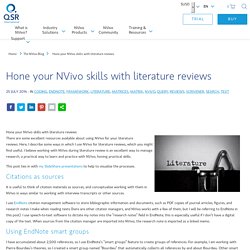

NVivo for your literature review- online tutorial. Coding for Literature Reviews. NVivo Endnote Lit review. Dealing with Data: Using NVivo in the Qualitative Data Analysis Process. Volume 3, No. 2, Art. 26 – May 2002 Dealing with Data: Using NVivo in the Qualitative Data Analysis Process Elaine Welsh Abstract: This paper will assess the way in which a qualitative data analysis software package—NVivo—can be used in the data analysis process.

Computer assisted qualitative data analysis software (CAQDAS) has been seen as aiding the researcher in her or his search for an accurate and transparent picture of the data whilst also providing an audit of the data analysis process as a whole—something which has often been missing in accounts of qualitative research. This paper will compare manual techniques in the qualitative data analysis of interview transcripts with the use of NVivo. Key words: reliability, validity, NVivo, qualitative data analysis, women local councillors Table of Contents 1. 2. 3. 4. 5. 6.
Notes References Author Citation 1. MASON (1996) suggests that in practice many researchers would use a combination of the above approaches. Using NVivo Tools for Literature Review. I use NVivo computer-aided qualitative data analysis software as part of my literature review process.This post describes some of the things I do as part of that process.* You can see an accompanying SlideShare here.

Background: My research studies PLT practitioners’ engagement with scholarship of teaching and learning in PLT. This study involves individual and extra-individual dimensions of practice. I am interested in how social structures (such as “law”) are inscribed into practices, and whether practices can affect or change those structures. As part of my research, I have collated about 2000 items of literature, which I need to organise effectively for my doctoral research and for the future. I use Endnote, and I am pretty happy with it. I collect all my references in Endnote, along with copies of articles etc in PDF format.
Smart groups help to organise the reference library around themes to which you frequently return during some stage of your research. Hone your NVivo skills with literature reviews. 25 July 2014 - IN coding, EndNote, framework, literature, matrices, matrix, NVivo, query, reviews, Scrivener, search, text There are some excellent resources available about using NVivo for your literature reviews.

Here, I describe some ways in which I use NVivo for literature reviews, which you might find useful. I believe working with NVivo during literature review is an excellent way to manage research, a practical way to learn and practice with NVivo, honing practical skills. This post ties in with my SlideShare presentations to help to visualise the processes. Citations as sources It is useful to think of citation materials as sources, and conceptualise working with them in NVivo in ways similar to working with interview transcripts or other sources.
Using EndNote smart groups I have accumulated about 2,500 references, so I use EndNote’s “smart groups” feature to create groups of references. Import and organize references in NVivo Explicit and emergent approaches Memos and writing up. Writing a literature review: six steps to get you from start to finish. Writing a literature review is often the most daunting part of writing an article, book, thesis, or dissertation.

“The literature” seems (and often is) massive. I have found it helpful to be as systematic as possible when completing this gargantuan task. Sonja Foss and William Walters* describe an efficient and effective way of writing a literature review. Their system provides an excellent guide for getting through the massive amounts of literature for any purpose: in a dissertation, an M.A. thesis, or an article or book in any field of study. Below is a summary of the steps they outline as well as a step-by-step method for writing a literature review. Step One: Decide on your areas of research: Before you begin to search for articles or books, decide beforehand what areas you are going to research. Step Two: Search for the literature: Conduct a comprehensive bibliographic search of books and articles in your area.
Step Three: Find relevant excerpts in your books and articles: Coding for Literature Reviews.